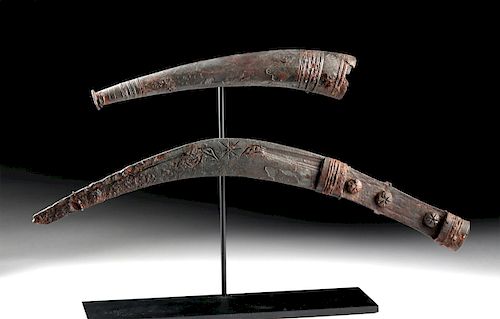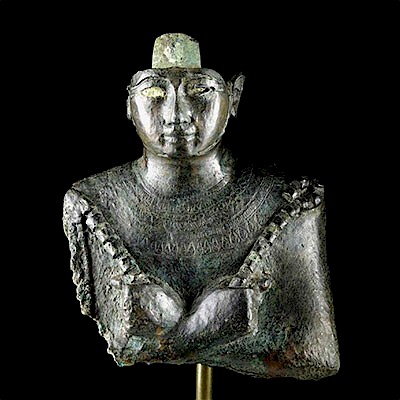Rare Balkan Celtic Iron Machaira / Sica with Sheath
Lot 41d
About Seller
Artemis Fine Arts
686 S Taylor Ave, Ste 106
Louisville, CO 80027
United States
Selling antiquities, ancient and ethnographic art online since 1993, Artemis Gallery specializes in Classical Antiquities (Egyptian, Greek, Roman, Near Eastern), Asian, Pre-Columbian, African / Tribal / Oceanographic art. Our extensive inventory includes pottery, stone, metal, wood, glass and textil...Read more
Estimate:
$4,000 - $6,000
Absentee vs Live bid
Two ways to bid:
- Leave a max absentee bid and the platform will bid on your behalf up to your maximum bid during the live auction.
- Bid live during the auction and your bids will be submitted real-time to the auctioneer.
Bid Increments
| Price | Bid Increment |
|---|---|
| $0 | $25 |
| $300 | $50 |
| $1,000 | $100 |
| $2,000 | $250 |
| $5,000 | $500 |
| $10,000 | $1,000 |
| $20,000 | $2,500 |
| $50,000 | $5,000 |
| $100,000 | $10,000 |
| $200,000 | $20,000 |
About Auction
By Artemis Fine Arts
May 22, 2019
Set Reminder
2019-05-22 10:00:00
2019-05-22 10:00:00
America/New_York
Bidsquare
Bidsquare : Exceptional Day 1: Antiquities Asian Fine Art
https://www.bidsquare.com/auctions/artemis-gallery/exceptional-day-1-antiquities-asian-fine-art-4129
Day 1 of an important 2-day auction featuring exceptional art from around the world - Egyptian, Greek, Etruscan, Roman, Viking, Russian, Near Eastern; Asian Art from China, Japan, Thailand, Vietnam, Burma, India; Fine Art from the 17th century to present. Artemis Fine Arts info@artemisgallery.com
Day 1 of an important 2-day auction featuring exceptional art from around the world - Egyptian, Greek, Etruscan, Roman, Viking, Russian, Near Eastern; Asian Art from China, Japan, Thailand, Vietnam, Burma, India; Fine Art from the 17th century to present. Artemis Fine Arts info@artemisgallery.com
- Lot Description
Central/Eastern Europe, Balkan Region (Slovenia, Serbia, Bulgaria), Celtic peoples, ca. early 1st millennium BCE. A well-preserved, curved, single-edged iron sword called a makhaira (machaira), also known as a sica, with a hammered flat tang studded with three iron sun ray-decorated bolts and a small pommel. It is accompanied by the sheath, which is cast from iron with decorative incised bands around its top and bottom and a flat, disc-shaped tip. The blade is wide below the thick tang before tapering to a point. Incised decorations on the surface show two birds - both of whom likely once had precious metal or stones inlaid as their bodies - and a sun-ray or sunburst motif between them, at the highest point of the blade when the dagger is held vertically. These incised motifs look very similar to ones on a machaira found in a grave alongside a sword and helmet at Montana in northwestern Bulgaria (see below for comparison). Size: 15.1" H (38.4 cm); 8.95" H (22.7 cm) on included custom stand.
Curved, single-edged swords developed during the Bronze Age in southeastern Europe, with various groups around the eastern Adriatic coast using them. One notable example is from the late La Tene cremation burial at Most na Soci, Slovenia, where a cremation burial included a sword of this type, a spearhead, and a fibula. In that burial, the sword and fibula had both been ritually destroyed as most metal grave goods were by the Celts.
See the similar example from Montana, Bulgaria, and several other similar examples from archaeological finds here: https://balkancelts.wordpress.com/2012/11/24/curved-sacrificial-daggers/
Provenance: private East Coast, USA collection
All items legal to buy/sell under U.S. Statute covering cultural patrimony Code 2600, CHAPTER 14, and are guaranteed to be as described or your money back.
A Certificate of Authenticity will accompany all winning bids.
We ship worldwide and handle all shipping in-house for your convenience.
#146589Both items have oxidized patinas that have not obscured the details. The hilt and tip are lost from the dagger, while the sheath has a loss from its upper edge. Other small losses are visible elsewhere.Condition
- Shipping Info
-
All shipping is handled in-house for your convenience. Your invoice from Artemis Gallery will include shipping calculation instructions. If in doubt, please inquire BEFORE bidding for estimated shipping costs for individual items.
-
- Buyer's Premium



 EUR
EUR CAD
CAD AUD
AUD GBP
GBP MXN
MXN HKD
HKD CNY
CNY MYR
MYR SEK
SEK SGD
SGD CHF
CHF THB
THB













